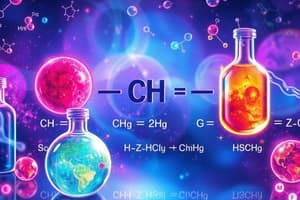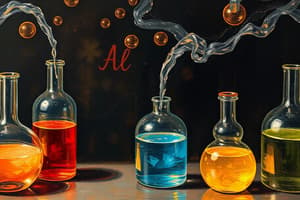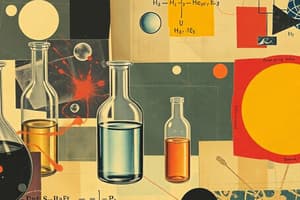Podcast
Questions and Answers
What happens to the magnesium ribbon when it is burned?
What happens to the magnesium ribbon when it is burned?
- It turns into a gas.
- It melts into liquid metal.
- It produces a black powder.
- It burns with a dazzling white flame. (correct)
A chemical reaction can occur without a change in the identity of the substance.
A chemical reaction can occur without a change in the identity of the substance.
False (B)
What is the product formed when magnesium burns in air?
What is the product formed when magnesium burns in air?
Magnesium oxide
When food is digested in our body, it undergoes a __________ change.
When food is digested in our body, it undergoes a __________ change.
Match the following activities with the substances involved:
Match the following activities with the substances involved:
Which of the following scenarios is an example of a chemical change?
Which of the following scenarios is an example of a chemical change?
Cooking food is an example of a physical change.
Cooking food is an example of a physical change.
What substance is produced when lead nitrate is involved in a chemical reaction?
What substance is produced when lead nitrate is involved in a chemical reaction?
What is indicated by a change in temperature during a chemical reaction?
What is indicated by a change in temperature during a chemical reaction?
A word-equation shows both reactants and products separated by a plus sign.
A word-equation shows both reactants and products separated by a plus sign.
What are the substances that undergo chemical change in a reaction called?
What are the substances that undergo chemical change in a reaction called?
Magnesium burned in oxygen produces __________.
Magnesium burned in oxygen produces __________.
Match the following terms with their correct descriptions:
Match the following terms with their correct descriptions:
Which of the following is NOT a sign that a chemical reaction has taken place?
Which of the following is NOT a sign that a chemical reaction has taken place?
Chemical reactions can only occur in a closed system.
Chemical reactions can only occur in a closed system.
The arrow in a word-equation indicates the direction of the __________.
The arrow in a word-equation indicates the direction of the __________.
What gas is emitted when lead nitrate is heated?
What gas is emitted when lead nitrate is heated?
The decomposition of lead nitrate produces only solid lead oxide.
The decomposition of lead nitrate produces only solid lead oxide.
What is the primary purpose of adding dilute sulfuric acid in the electrolysis of water experiment?
What is the primary purpose of adding dilute sulfuric acid in the electrolysis of water experiment?
The chemical reaction for the decomposition of lead nitrate is represented as: 2Pb(NO3)2(s) ______________ 2PbO(s) + 4NO2(g) + O2(g).
The chemical reaction for the decomposition of lead nitrate is represented as: 2Pb(NO3)2(s) ______________ 2PbO(s) + 4NO2(g) + O2(g).
Match the following components of the electrolysis setup with their functions:
Match the following components of the electrolysis setup with their functions:
During the electrolysis experiment, what happens to the gases formed at the electrodes when a burning candle is brought near them?
During the electrolysis experiment, what happens to the gases formed at the electrodes when a burning candle is brought near them?
The amount of gas collected at both electrodes during electrolysis is expected to be equal.
The amount of gas collected at both electrodes during electrolysis is expected to be equal.
What observation is noted when lead nitrate is heated?
What observation is noted when lead nitrate is heated?
What happens during the reaction between copper(II) oxide and hydrogen gas?
What happens during the reaction between copper(II) oxide and hydrogen gas?
In a redox reaction, one reactant is always reduced and the other is always oxidized.
In a redox reaction, one reactant is always reduced and the other is always oxidized.
What is the product formed when copper combines with oxygen?
What is the product formed when copper combines with oxygen?
In a reaction, if a substance loses oxygen, it is said to be __________.
In a reaction, if a substance loses oxygen, it is said to be __________.
Match the following reactions with their corresponding processes:
Match the following reactions with their corresponding processes:
Which statement is true regarding oxidation?
Which statement is true regarding oxidation?
In the reaction ZnO + C → Zn + CO, carbon is reduced.
In the reaction ZnO + C → Zn + CO, carbon is reduced.
During the burning of magnesium in air, what type of reaction occurs?
During the burning of magnesium in air, what type of reaction occurs?
What is the reddish-brown coating that forms on iron over time called?
What is the reddish-brown coating that forms on iron over time called?
Corrosion only affects iron and no other metals.
Corrosion only affects iron and no other metals.
What is the process called when fats and oils become rancid?
What is the process called when fats and oils become rancid?
The green coating formed on copper due to corrosion is known as __________.
The green coating formed on copper due to corrosion is known as __________.
Match the following terms with their definitions:
Match the following terms with their definitions:
Why do manufacturers flush bags of chips with nitrogen?
Why do manufacturers flush bags of chips with nitrogen?
Identify one effect of corrosion on everyday objects.
Identify one effect of corrosion on everyday objects.
Keeping food in airtight containers can help slow down rancidity.
Keeping food in airtight containers can help slow down rancidity.
What are the products formed when hydrogen sulphide gas burns in air?
What are the products formed when hydrogen sulphide gas burns in air?
Zinc carbonate decomposes to form zinc oxide and carbon dioxide.
Zinc carbonate decomposes to form zinc oxide and carbon dioxide.
What is considered an endothermic reaction?
What is considered an endothermic reaction?
The process of __________ involves a single replacement of elements in a chemical reaction.
The process of __________ involves a single replacement of elements in a chemical reaction.
Match the following types of reactions with their examples:
Match the following types of reactions with their examples:
Which of the following reactions is an example of a double displacement reaction?
Which of the following reactions is an example of a double displacement reaction?
Respiration is classified as a decomposition reaction.
Respiration is classified as a decomposition reaction.
What characterizes an exothermic reaction?
What characterizes an exothermic reaction?
Flashcards
Chemical Reaction
Chemical Reaction
A process where the nature and identity of substances change.
Chemical Change
Chemical Change
A reaction where the composition of the substance alters.
Magnesium Burning
Magnesium Burning
Magnesium reacts with oxygen to form magnesium oxide.
Lead Nitrate Solution
Lead Nitrate Solution
Signup and view all the flashcards
Zinc Granules
Zinc Granules
Signup and view all the flashcards
Dilute Acid
Dilute Acid
Signup and view all the flashcards
Magnesium Oxide
Magnesium Oxide
Signup and view all the flashcards
Chemical Equation
Chemical Equation
Signup and view all the flashcards
Chemical Reaction
Chemical Reaction
Signup and view all the flashcards
Reactants
Reactants
Signup and view all the flashcards
Products
Products
Signup and view all the flashcards
Word Equation
Word Equation
Signup and view all the flashcards
Chemical Indicators
Chemical Indicators
Signup and view all the flashcards
Chemical Equation
Chemical Equation
Signup and view all the flashcards
Observation
Observation
Signup and view all the flashcards
Evidence of Reaction
Evidence of Reaction
Signup and view all the flashcards
Decomposition reaction
Decomposition reaction
Signup and view all the flashcards
Lead Nitrate decomposition
Lead Nitrate decomposition
Signup and view all the flashcards
Nitrogen Dioxide
Nitrogen Dioxide
Signup and view all the flashcards
Electrolysis of water
Electrolysis of water
Signup and view all the flashcards
Electrodes
Electrodes
Signup and view all the flashcards
Hydrogen gas
Hydrogen gas
Signup and view all the flashcards
Oxygen gas
Oxygen gas
Signup and view all the flashcards
Gas volume comparison (electrolysis)
Gas volume comparison (electrolysis)
Signup and view all the flashcards
Oxidation
Oxidation
Signup and view all the flashcards
Reduction
Reduction
Signup and view all the flashcards
Redox Reaction
Redox Reaction
Signup and view all the flashcards
Oxidized substance
Oxidized substance
Signup and view all the flashcards
Reduced substance
Reduced substance
Signup and view all the flashcards
Example reaction (1.29)
Example reaction (1.29)
Signup and view all the flashcards
Example reaction (1.31)
Example reaction (1.31)
Signup and view all the flashcards
Example reaction (1.32)
Example reaction (1.32)
Signup and view all the flashcards
Corrosion
Corrosion
Signup and view all the flashcards
Rusting
Rusting
Signup and view all the flashcards
Rancidity
Rancidity
Signup and view all the flashcards
Oxidation
Oxidation
Signup and view all the flashcards
Antioxidant
Antioxidant
Signup and view all the flashcards
Chemical Equation
Chemical Equation
Signup and view all the flashcards
Physical States (in equations)
Physical States (in equations)
Signup and view all the flashcards
Double Displacement Reaction Example
Double Displacement Reaction Example
Signup and view all the flashcards
Exothermic Reaction
Exothermic Reaction
Signup and view all the flashcards
Endothermic Reaction
Endothermic Reaction
Signup and view all the flashcards
Decomposition Reaction
Decomposition Reaction
Signup and view all the flashcards
Combination Reaction
Combination Reaction
Signup and view all the flashcards
Displacement Reaction
Displacement Reaction
Signup and view all the flashcards
Double Displacement Reaction
Double Displacement Reaction
Signup and view all the flashcards
Precipitation Reaction
Precipitation Reaction
Signup and view all the flashcards
Oxidation
Oxidation
Signup and view all the flashcards
Study Notes
Chemical Reactions and Equations
- Chemical reactions involve changes in the nature and identity of substances
- Chemical reactions are indicated by changes in state, colour, temperature, or gas evolution.
- Activity 1.1 demonstrates chemical reactions by burning magnesium
- Activity 1.2 shows a reaction between lead nitrate and potassium iodide solutions
- Activity 1.3 highlights reactions involving zinc, hydrochloric acid and sulphuric acid
- Chemical equations are concise representations of reactions, using chemical formulas instead of words
- Reactants are substances undergoing change
- Products are substances formed by the reaction
- The general form of a chemical equation: Reactants → Products
- Chemical equations must be balanced; the number of atoms of each element is the same on both sides of the equation.
- Activity 1.4 demonstrates a combination reaction, whereby two or more substances form a single product. (e.g., Calcium oxide reacting with water.)
- Activity 1.5 demonstrates a decomposition reaction, where a reactant breaks down into two or more products, usually by heating. (e.g., Ferrous sulphate decomposing into ferric oxide, sulphur dioxide, and sulphur trioxide.)
- Activity 1.6 further illustrates a decomposition reaction. (e.g., Lead nitrate decomposing into lead oxide, nitrogen dioxide and oxygen).
- Activity 1.7 illustrates electrolysis of water that can be used to obtain elemental hydrogen or oxygen.
- Activity 1.8 demonstrates a change in appearance caused by sunlight on silver chloride that breaks down into silver and chlorine.
- Activity 1.9 demonstrates a single displacement reaction where one element in a compound is displaced by another element.
- Activity 1.10 details a double displacement reaction where two compounds exchange ions to form two new compounds.
- Activity 1.11 shows how oxidation happens when a substance gains oxygen and reduction happens when a substance loses oxygen.
Studying That Suits You
Use AI to generate personalized quizzes and flashcards to suit your learning preferences.
Related Documents
Description
Test your knowledge on chemical reactions and equations with this quiz. Explore the indicators of chemical changes, the significance of reactants and products, and the necessity of balancing equations. Activities highlight various reactions that demonstrate these concepts in action.




